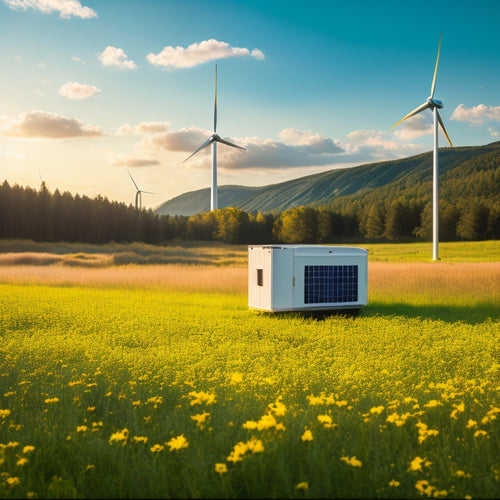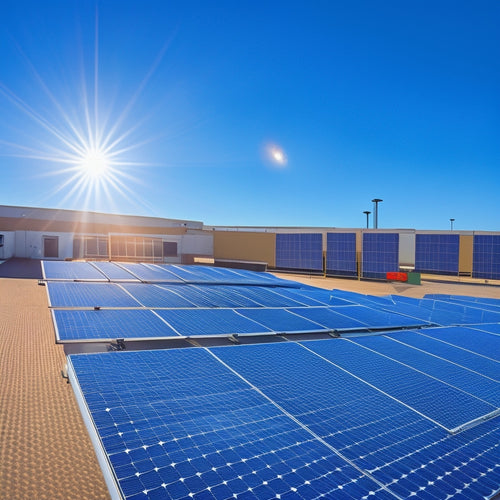
Maximize Energy Independence With Efficient System Design
Share
By optimizing your solar panel placement, selecting high-efficiency inverters, and sizing batteries for energy storage, you can maximize your energy independence. Consider factors like shading analysis, inverter sizing, and battery chemistry to guarantee your system operates at peak performance. Efficient system design also involves minimizing energy losses through load management and thermal insulation, as well as designing for seasonal variations. By integrating these components and monitoring system performance, you'll be on your way to achieving energy independence. Now, take a closer look at each of these elements to access the full potential of your energy independence.
Overview
- Optimize solar panel placement and orientation to maximize energy production, and consider high-efficiency charging solutions for energy maximization.
- Select high-efficiency inverters with peak ratings above 98% and optimize inverter sizing to minimize energy losses and enhance performance.
- Accurately size energy storage batteries based on load profiling, battery chemistry, and depth of discharge to ensure reliable system design.
- Implement load management techniques and energy-efficient appliances to minimize energy losses and optimize energy consumption patterns.
- Monitor system performance in real-time to detect potential issues, optimize energy independence, and ensure continuous operation of critical systems.
Optimizing Solar Panel Placement
When designing an energy-independent system, refining solar panel placement is vital to maximize energy harvesting. You'll need to take into account solar orientation, ensuring your panels face the best direction to capture the most sunlight.
Conduct a shading analysis to identify potential obstructions and adjust your panel placement accordingly. The roof angle and panel alignment also play significant roles in energy production. Select installation techniques that accommodate your roof's unique features and aesthetic considerations.
Additionally, it's important to assess high-efficiency solar charging solutions to maximize energy harvest, and evaluate the capacity of solar panel arrays and other charging sources, accounting for energy losses due to inefficiencies.
Don't forget to research local regulations and investigate community solar options if possible. Regular maintenance practices and energy audits will help you fine-tune your system for peak performance.
Selecting Efficient Inverters
When selecting an inverter, you'll want to prioritize high efficiency ratings to minimize energy losses and maximize your system's overall performance.
You'll need to take into account the inverter's efficiency under various operating conditions, including partial load and high temperatures. Confirm compliance with industry standards like UL 1741 for safe operation, and focus on high peak efficiency ratings, typically above 98%, for maximum energy harvesting.
Inverter Efficiency Ratings
Your system's inverter is the backbone of energy independence, converting DC power from your renewable sources into usable AC power for your home or business.
When selecting an inverter, it's essential to evaluate its efficiency ratings. Look for inverters that meet high efficiency standards, such as those set by the California Energy Commission (CEC).
Advanced inverter technology enables real-time monitoring and control for ideal energy harvesting, and next-gen inverters enhance solar energy utilization with advanced design, leading to significant power density increases for efficient energy conversion and lower costs.
A higher efficiency rating translates to more power output and reduced energy losses. Additionally, evaluate inverter technologies that prioritize grid compatibility, load management, and power quality.
Thermal performance and installation practices also impact an inverter's lifespan. By choosing an efficient inverter, you'll maximize your energy independence and minimize your reliance on the grid.
Optimizing Inverter Sizing
Select the right inverter size to release your system's full potential.
When choosing an inverter, you'll encounter different inverter types, each with unique characteristics. String inverters are suitable for residential systems, while central inverters are better for commercial applications. Microinverters offer flexibility, but at a higher cost.
To optimize inverter sizing, consider your system's load management requirements. Assess your energy needs during peak hours and design your system to handle those loads.
Oversizing your inverter can lead to energy waste and increased costs. Undersizing may result in reduced performance and efficiency.
Sizing Batteries for Energy Storage
Accurate sizing of energy storage batteries is critical to ensuring a reliable and efficient system design for energy independence. You must consider factors like load profiling, battery chemistry, and depth of discharge (DOD) to determine the best battery size for your system.
| Battery Chemistry | Cycle Life | DOD |
|---|---|---|
| Lead-Acid | 500-1000 | 50% |
| Lithium-Ion | 3000-5000 | 80% |
| Nickel-Cadmium | 1000-2000 | 60% |
| Nickel-Metal Hydride | 500-1000 | 70% |
| Sodium-Ion | 2000-3000 | 75% |
Minimizing Energy Losses
Every efficient system design for energy independence requires minimizing energy losses to maximize the overall system performance.
You'll want to identify areas of inefficiency through energy audits, which will help you pinpoint opportunities for improvement.
One key strategy is to optimize your building's thermal insulation, ensuring that heat and cool air aren't escaping.
Installing energy-efficient appliances and implementing load balancing techniques will also help reduce energy consumption.
By leveraging renewable energy sources and integrating smart home technology, you can further minimize losses.
Consider your building's orientation and how it affects your energy consumption patterns.
Designing for Seasonal Variations
When designing an energy-independent system, you'll need to take into account the fluctuating energy demands that come with seasonal changes.
In winter, you'll need to guarantee your system can meet increased energy demands for heating and lighting, while in summer, you'll want to capitalize on surplus energy from longer days and higher solar irradiance.
Winter Energy Demands
Designing an energy-independent system requires careful consideration of seasonal variations in energy demand, and winter is a critical period to focus on.
You'll want to implement winter energy strategies that prioritize heating efficiency to minimize energy consumption. This means optimizing your system's performance during the coldest months when energy demand peaks.
Consider investing in high-efficiency heating systems, such as heat pumps or radiant floor heating, which can provide consistent warmth while reducing energy waste.
Additionally, verify your insulation is adequate, and seal any air leaks to prevent heat loss.
Summer Energy Surpluses
As winter's chill gives way to summer's warmth, your energy-independent system faces a new challenge: utilizing the abundance of energy generated during the sunniest months.
During peak production, your solar energy strategies must adapt to handle the increased output. You'll want to design your system to take advantage of summer energy surpluses by storing excess energy in batteries or using it to power energy-intensive applications like water pumping or cooling systems.
Monitoring System Performance
Your energy-independent system's performance hinges on its ability to be monitored and optimized in real-time. You need to track key performance metrics, such as energy production, consumption, and storage levels, to identify areas of improvement.
Data analytics tools help you make sense of this data, providing significant understanding into your system's operation. By monitoring your system's performance, you can detect potential issues before they become major problems, reducing downtime and increasing overall efficiency.
This real-time monitoring enables you to make informed decisions, optimizing your system's performance and maximizing your energy independence. With the right monitoring and analytics tools, you'll be able to fine-tune your system, ensuring it runs smoothly and efficiently, giving you the freedom to live life on your own terms.
Integrating Energy Storage Systems
Energy storage systems play a critical role in guaranteeing a reliable and efficient energy-independent system.
You'll want to integrate them into your design to optimize energy management. With advancements in battery technology, you can store excess energy generated by your system during the day for use during periods of low energy production or at night. This guarantees a steady supply of power, even when the grid is unavailable.
When selecting a battery, consider factors like depth of discharge, round-trip efficiency, and lifespan to guarantee you get the most out of your investment.
Frequently Asked Questions
Can I Use Energy Independence Systems in Urban Areas?
You can utilize urban solar power and wind potential in urban areas, leveraging rooftops and vertical spaces for energy generation, allowing you to reduce reliance on grid electricity and increase your autonomy.
Are Energy Storage Systems Safe for Residential Use?
Like a fortress guarding your autonomy, you'll find energy storage systems, built on advanced battery technology, are fortified with stringent safety regulations, ensuring a secure haven for residential use, enabling you to wield control over your energy destiny.
Do Energy Independence Systems Work During Power Outages?
When the grid fails, you'll rely on your energy independence system; thankfully, it's designed to work during power outages, ensuring power resilience and system reliability, so you can maintain your freedom and autonomy without interruptions.
Can I Add Energy Independence Systems to Existing Homes?
You're not stuck between a rock and a hard place; you can retrofit your existing home with energy independence systems. Integrate solar panels and prioritize energy efficiency upgrades to break free from the grid's shackles.
Are Energy Independence Systems Environmentally Friendly?
You're right to wonder if energy independence systems are environmentally friendly; fortunately, they often incorporate eco-friendly technologies, reducing your sustainability impact and carbon footprint, allowing you to break free from grid reliance while promoting a cleaner environment.
Ready to Buy
By following these design principles, you'll be well on your way to maximizing energy independence. Notably, a well-designed system can reduce energy waste by up to 20%, according to the National Renewable Energy Laboratory. With optimized solar panel placement, efficient inverters, and properly sized batteries, you'll be generating and storing energy like a pro. Add in monitoring and seasonal adjustments, and you'll be enjoying reliable, renewable energy all year round.
Related Posts
-

Is This the Future of Alternative Energy Systems
Yes, alternative energy systems are shaping the future of energy. Innovations in solar and wind technologies are driv...
-

Sustainable and Eco-Friendly Generators for a Reduced Carbon Footprint
Sustainable and eco-friendly generators are perfect for cutting your carbon footprint and increasing energy efficienc...
-

Essential Solar Panel Mounts for Commercial Properties
When it comes to essential solar panel mounts for your commercial property, durability and wind resistance are key fa...


